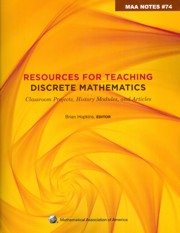Book contents
- Frontmatter
- Introduction
- Dedication
- Contents
- I Classroom-tested Projects
- II Historical Projects in Discrete Mathematics and Computer Science
- Introduction
- Binary Arithmetic: From Leibniz to von Neumann
- Arithmetic Backwards from Shannon to the Chinese Abacus
- Pascal's Treatise on the Arithmetical Triangle: Mathematical Induction, Combinations, the Binomial Theorem and Fermat's Theorem
- Early Writings on Graph Theory: Euler Circuits and The Königsberg Bridge Problem
- Counting Triangulations of a Convex Polygon
- Early Writings on Graph Theory: Hamiltonian Circuits and The Icosian Game
- Are All Infinities Created Equal?
- Early Writings on Graph Theory: Topological Connections
- A Study of Logic and Programming via Turing Machines
- Church's Thesis
- Two-Way Deterministic Finite Automata
- III Articles Extending Discrete Mathematics Content
- IV Articles on Discrete Mathematics Pedagogy
- About the Editor
Pascal's Treatise on the Arithmetical Triangle: Mathematical Induction, Combinations, the Binomial Theorem and Fermat's Theorem
from II - Historical Projects in Discrete Mathematics and Computer Science
- Frontmatter
- Introduction
- Dedication
- Contents
- I Classroom-tested Projects
- II Historical Projects in Discrete Mathematics and Computer Science
- Introduction
- Binary Arithmetic: From Leibniz to von Neumann
- Arithmetic Backwards from Shannon to the Chinese Abacus
- Pascal's Treatise on the Arithmetical Triangle: Mathematical Induction, Combinations, the Binomial Theorem and Fermat's Theorem
- Early Writings on Graph Theory: Euler Circuits and The Königsberg Bridge Problem
- Counting Triangulations of a Convex Polygon
- Early Writings on Graph Theory: Hamiltonian Circuits and The Icosian Game
- Are All Infinities Created Equal?
- Early Writings on Graph Theory: Topological Connections
- A Study of Logic and Programming via Turing Machines
- Church's Thesis
- Two-Way Deterministic Finite Automata
- III Articles Extending Discrete Mathematics Content
- IV Articles on Discrete Mathematics Pedagogy
- About the Editor
Summary
Introduction
Blaise Pascal (1623–1662) was born in Clermont-Ferrand in central France. Even as a teenager his father introduced him to meetings for mathematical discussion in Paris run by Marin Mersenne, who served as a primary conduit for transmitting mathematical ideas widely at that time, before the existence of any research journals. He quickly became involved in the development of projective geometry, the first in a sequence of highly creative mathematical and scientific episodes in his life, punctuated by periods of religious fervor. Around age twenty-one he spent several years developing a mechanical addition and subtraction machine, in part to help his father in tax computations as a local administrator. It was the first of its kind ever to be marketed. Then for several years he was at the center of efforts to understand vacuum, which led to an understanding of barometric pressure. In fact the scientific unit of pressure is named the pascal. He is also known for Pascal's Law on the behavior of fluid pressure.
Around 1654 Pascal conducted his studies on the Arithmetical Triangle (“Pascal's Triangle”) and its relationship to probabilities. His correspondence with Pierre de Fermat (1601–1665) in that year marks the beginning of probability theory. Several years later, Pascal refined his ideas on area problems via the method of indivisibles already being developed by others, and solved various problems of areas, volumes, centers of gravity, and lengths of curves.
- Type
- Chapter
- Information
- Resources for Teaching Discrete MathematicsClassroom Projects, History Modules, and Articles, pp. 185 - 196Publisher: Mathematical Association of AmericaPrint publication year: 2009

